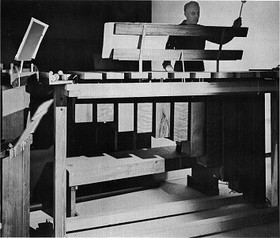I arrived at this sanctuary having experienced quite a bit of microtonal music but not much Harry Partch. John Payne’s resonant LA Weekly article on the late composer serves as sensitive background. But listening to John Schneider’s 13-member ensemble -- called Partch and using duplicates of the man’s self-built 43-tone instruments -- I just had to forget what I didn’t know and stick my ears into the moment.
The moment felt like about 1989. That was 15 years after Partch’s death, and four decades after the composition of the music assembled for REDCAT’S “Dark/Light” Partch program. In Los Angeles, it was a time of great artistic nervousness. The European postmodern notions that had been festering for most of the century had erupted onto the surface of the culture. Films released that year included expressions of nihilistic digust such as “Sex, Lies, and Videotape” and “The Cook, the Thief, His Wife and Her Lover.” In music, radical reconceptualizations by Morbid Angel (heavy metal) and KMFDM, Ministry and Skinny Puppy (industrial) made the nation’s Top 20 albums; gangsta rap was on the rise. You couldn’t avoid visual art about visual art. Irony was king.
In 1989, Partch must have been looking down from heaven with great puzzlement. As nearly as I can learn, he was a passionate man who wanted to unlock human emotion by going back to our mythic and sonic roots. So I wonder what he would have thought about the interpretations of his music by Schneider, an educator, a musician and the host of KPFK’s “Global Village.”
At REDCAT, the main friction came from the vocalists, who did everything possible to undermine the poetic/emotional words -- some written by Partch (“So eager for the pool of oblivion”), some by James Joyce, Thomas Wolfe and Lewis Carroll. The singers executed twitchy gestures, gasped unnaturally, paraded comically. Much has been made of Partch’s reaction against sterile “serious” music, which might account for this evening’s emphasis on whimsy. Samuel Beckett and Charlie Chaplin weighted whimsy with the deepest darkness, and I think Partch had similar values. Was Schneider’s conception of dark/light, tilted toward light even in the opening “dark” segment, an update? I don’t know, but I didn’t hear much that felt like the severe postwar social adjustments of 1950. The spoken-word narration, most of which Schneider undertook himself, lacked gravity; he was a lot better plucking or sliding on one of several microtonal guitars.
In fact, those unique instruments -- the guitars, the viola, the marimbas, the organ, the harp, the hanging bowls, the flute -- became the evening’s focus, attacked with great precision by a capable ensemble including Erin Barnes, T.J. Troy and David Johnson. The wheezing organ tones and the chest-rattling clonks of the huge bass marimba made a special impression as the different instruments combined in many different configurations for the rounds, marches and deflated folkisms. Except in the impressively impenetrable massings of the guitar chords, it was easy to forget that this was microtonal music -- it’s based on harmonic divisions that, though unfamiliar, sound very natural.
Maybe it was inevitable that the music sounded most whole under the direction of Partch himself -- the insistent mallet work heard on the screening of “Windsong,” Madeline Tourtelot’s lovely 1958 filmic abstraction of water, sand, leaves and birds (combined with an awkward narrative of a modern Daphne and Apollo). Here we got the strongest impression of Partch as a man who valued beauty above anything else, and who strove to yank the hoods off our heads so we could perceive it. Nothing ironic about that.

